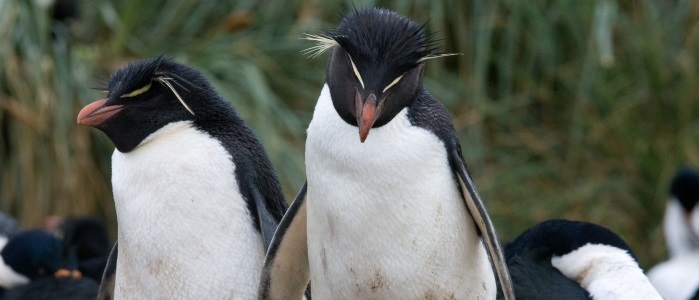Interactions
Eudyptes chrysocome interact
 with
other organisms in several different ways. They hold an
intermediate position in the food web. This causes them to be
vulnerable when changes are made within the food web above and
below them. Southern Rockhopper penguins eat krill which
resemble
shrimp, squid (Humboldt Squid), crustaceans (King
Crab), small
octopuses, and
fish among other seafood organisms by swimming in the ocean and
catching them with their mouth (Dehnhard et al. 2013a).
Eudyptes
chrysocome must be very productive as a result because they have
a limited foraging range (Dehnhard et al. 2013a).
with
other organisms in several different ways. They hold an
intermediate position in the food web. This causes them to be
vulnerable when changes are made within the food web above and
below them. Southern Rockhopper penguins eat krill which
resemble
shrimp, squid (Humboldt Squid), crustaceans (King
Crab), small
octopuses, and
fish among other seafood organisms by swimming in the ocean and
catching them with their mouth (Dehnhard et al. 2013a).
Eudyptes
chrysocome must be very productive as a result because they have
a limited foraging range (Dehnhard et al. 2013a).
Humans
participate in intensive
fisheries around the same areas where
Eudyptes chrysocome inhabits. This competitive relationship may
produce a serious problem for Southern Rockhopper penguins if
humans overfish, causing a shortage in food for the penguins
(Dehnhard et al. 2013b). In addition to the issues lying below
them in the food web, the Southern Rockhopper penguins have to
be wary of marine mammals like petrels and sea lions, which are
above them. A “trickle down” effect resulting from top-down
changes in food web structures has lead to increased secondary
predation. For example, petrels follow sea lions, which have
been found to prey on Eudyptes chrysocome, and eat offal (edible
internal organs) left over by sea lions (Raya Rey et al. 2012).

Aside from interacting with other organisms, Southern Rockhopper penguins have to compete with the environment. The blend of wind direction and wind speed has proved to be a costly influence on foraging success. Prey species tend to be influenced based on the wind conditions, therefore, food could be plentiful one week and scarce the next (Dehnhard et al. 2013a).
Back To Reproduction
Home
References Contact Us
Continue To Facts
